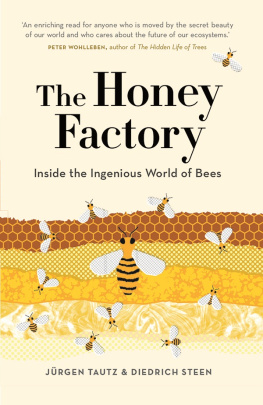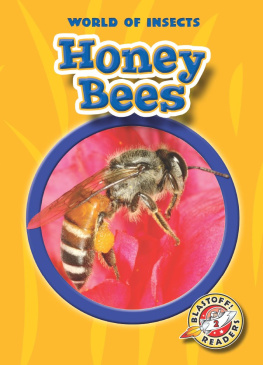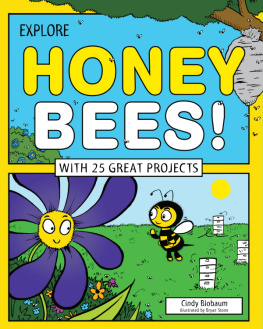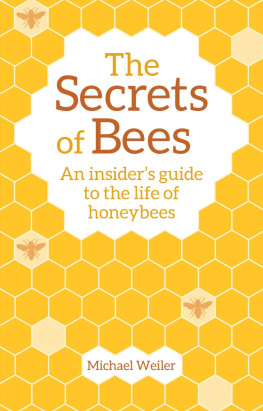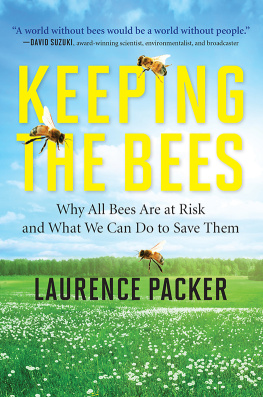Acknowledgements
This book is not only our work. We owe thanks to many who shared their knowledge with us, encouraged and supported us. We extend our thanks to all those in the Gtersloher publishing house. Ralf Markmeier, as publisher, who made it possible to publish a book by a colleague. Nicole Neumann, with boundless patience was responsible for impeccable typesetting. Sigrid Fortkord accompanied and encouraged us as our reader. Gudrun Krieger oversaw the corrections with professional care and all the Gtesloher colleagues thoroughly engaged themselves with this project. Their enthusiasm carried us through!
I, Diedrich Steen, thank those who taught me beekeeping. My father, Dirk Steen, who inherited three bee colonies from my grandfather, Abram Strohschneider, and so brought bees into the home, and Johann Noichl, who guided me to the right path after my catastrophic start. And Dr Gerd Liebig, who with his book Einfach Imkern and several meetings firmly established the way. I thank Pia Aumeier, whose courses I continue to experience as a steadily flowing source of insights. And I thank Michael Schlangenotto, Bruno Grndtkemeier, Franz Austermann, Siegfried Timm, Reinhard Diekhans and Dr Alexander Lojewski. My continuous exchanges with all of you prevented me from much beekeeping stupidity. A special thanks to my wife, Inge Bohnke-Steen. She not only, more or less, gave me my first bees and, more or less, endured the fact that on separator days everything was sticky. She also encouraged me to undertake this book and put up with the reduced time we had to spend together due not only to the demands of my career, but also because of the book.
I, Jrgen Tautz, thank all those that awakened my very late interest in honey bees, which unfolded into a fascinating area of research. Martin Lindauer for the crafty gift of a bee colony and the reproach, said with a twinkle in his eye, that it is an error for zoologists not to interest themselves in bees. I thank my wife, Rosemarie Mller-Tautz, and my children, Meiko, Silke and Mona, for their, to my surprise, endless understanding for my work and the not always easily endured effect on the immediate surroundings. I thank all my colleagues, students, beekeepers and other bee friends who feel included, for their encouragement and contributions.
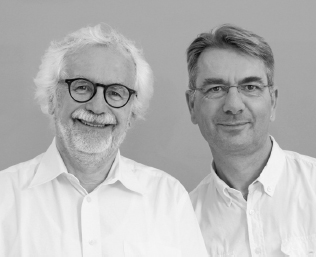
Jrgen Tautz is an internationally recognised expert on bees and professor emeritus at Wrzburg University. Since 2006 he has been in charge of the HOneyBee Online Studies (HOBOS) interdisciplinary project. Tautz has authored numerous publications and been awarded several prizes for his work in science education.
Diedrich Steen is a publishing director. Bees have been kept in his family for over 100 years, and he has been an active beekeeper himself for twenty years.
Bibliography
F.G. Barth, Biologie einer Begegnung: Die Partnerschaft der Insekten und Blumen, Deutsche Verlags-Anstalt Stuttgart, 1982.
R. Basile, C.W. Pirk & J. Tautz, Trophallactic activities in the honey bee brood nest Heaters get supplied with high performance fuel, Zoology, vol. 111, 2008, pp. 43341.
D. Bauer & K. Bienenfeld, Hexagonal combs of honey bees are not produced by a liquid equilibrium process, Naturwissenschaften, vol. 100, 2013, pp. 459.
M. Beye & M. Hasselmann, Mnnchen, die keiner Vater haben. Neues von der geschlecterentwicklung am Beispiel der Biene, Biologen heute, vol. 2, 2004, pp. 39.
F. Bock, Untersuchungen zu natrlicher und manipulierter Aufzucht von Apis mellifera: Morphologie, Kognition und Verhalten, Dissertation, Universitt Wrzburg, 2005.
B. Bujok, Thermoregulation im Brutbereich der Honigbiene Apis mellifera carnica, Dissertation, Universitt Wrzburg, 2005.
L. Chittka & J. Tautz, The spectral input to the honey bee visual odometry, Journal of Experimental Biology, vol. 206, 2002, pp. 23937.
D. Clarke, H. Whitney, G. Sutton & D. Robert, Detection and learning of floral electric fields by bumblebees, Science, vol. 340, 2013.
R. Dawkins, The Selfish Gene, Springer, New York, 2014 (originally published 1976).
R.J. De Marco, J.M. Gurevitz & R. Menzel, Variablity in the encoding of spatial information by dancing bees, Journal of Experimental Biology, vol. 211, 2008, pp. 163544.
Deutscher Imkerbund E.V., Jahresbericht 2015/2016, Wachtberg, 2016.
A.G. Dyer & S.K. William, Mechano-optical lens array to simulate insect vision photographically, The Imaging Science Journal, vol. 53, 2005, pp. 20913.
H.G. Esch, ber die Schallerzeugung beim Werbetanz der Honigbiene, Zeitschrift fur Vergleichende Physiologie, vol. 45, 1961, pp. 111.
H.G. Esch & J.E. Burns, Honey bees use optical flow to measure the distance to a food source, Naturwissenschaften, vol. 82, 1995, pp. 2850.
H.G. Esch, S. Zhang, M.V. Srinivasan & J. Tautz, Honey bee dances communicate distances measured by optic flow, Nature, vol. 411, 2001, pp. 5813.
M. Fehler, M. Kleinhenz, F. Klgl, F. Puppe & J. Tautz, Caps and gaps: A computer model for studies on brood incubation strategies in honey bees (Apis mellifera carnica), Naturwissenschaften, vol. 94, 2007, pp. 67580.
T.E. Ferrari & J. Tautz, Severe honey bee (Apis mellifera) losses correlate with geomagnetic disturbances in Earths atmosphere, Journal of Astrobiology, vol. 134, 2015.
J.K. Fischer, T. Mller, A-K. Spatz, U. Greggers, B. Grnewald & R. Menzel, Neonicotinoids interfere with specific components of navigation in honey bees, PLOS ONE, 2014.
G. Friedmann, Bienengem imkern das Praxishandbuch, BLV Buchverlag, Mnchen, 2016.
K. von Frisch, Tanzsprache und Orientierung der Bienen, Springer Verlag, Berlin, Heidelberg, New York, 1965.
K. von Frisch & R. Jander, ber den Schwnzeltanz der Bienen, Zeitschrift fur Vergleichende Physiologie, vol. 40, 1957, pp. 23963.
K. von Frisch & M. Lindauer, Aus dem Leben der Bienen, Springer Berlin, Heidelberg, New York, 1993.
B. Frhlich, J. Tautz & M. Riederer, Chemometric classification of comb and cuticular waxes of the honey bee Apis mellifera carnica, Journal of Chemical Ecology, vol. 26, 2000, pp. 12337.
H. Gtschenberger, T. Azzami, J. Tautz & H. Beier, Antibacterial immune competence of honey bees (Apis mellifera) is adapted to different life stages and environmental risks, PLOS ONE, vol. 8, 2013, e66415.
J.L. Gould, Honey bee communication: The dance language controversy, PhD thesis, Rockefeller University, New York, 1975.
U. Greggers, G. Koch, V. Schmidt, A. Drr, A. Floriou-Servou, D. Piepenbrock, M.C. Gpfert & R. Menzel, Reception and learning of electrical fields in bees, Proceedings of the Royal Society B, 2013.
H.J. Gross, M. Pahl, A. Si, H. Zhu, J. Tautz & S. Zhang, Number-based visual generalisation in the honey bee, PLOS ONE, vol. 4, no. 1, 2009.
Gymnasium Wendelstein, Schwnzeltanz und Brauseflug-kommunikation der Bienen im Stock und an der Futterstelle. Ein Beitrag zur berprfung einer Darstellung auch in Schulbchern, Wettbewerbsbeitrag fr Jugend forscht, 2017.
W.D. Hamilton, Narrow Roads of Gene Land, Volume 1: The Evolution of Social Behaviour, Oxford University Press, 1996.
B. Heinrich, The Hot-Blooded Insects: Strategies and Mechanisms of Thermoregulation, Springer, Berlin, Heidelberg, New York, 1993.
R. Hepburn, Honey Bees and Wax
Next page
